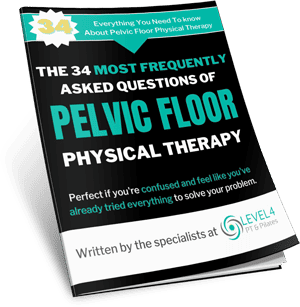
Hey ladies… Do you have a feeling of increased pressure or a feeling of heaviness in the vaginal or rectal area? Maybe you feel like something is out of place and not quite looking the same down there like it used to. Maybe it scared the daylights out of you when you went to the bathroom and you actually saw something poking out. “Wait, was this here before?”
Feelings of frustration and even embarrassment are experienced by many women after not getting the answers they need, and many are often scared of what has changed with their body when experiencing symptoms of prolapse. This is what I hear from my clients who ask if this is something that is normal after labor and delivery.
Some women experience symptoms within weeks of childbirth, while others reach their 50s and 60s and never even knew this was a risk after years of lifting, pushing, pulling, and doing activities with a weak core and pelvic floor. Some were considering surgery because their doctors said that was the solution.
“This can happen to me?”
When pregnancy and childbirth weaken or stretch the pelvic floor muscles and the surrounding tissue, one or more of the organs they support – the uterus, bladder, and bowel – can bulge into the vagina. This is called prolapse.
Some women experience prolapse after childbirth when the structures that support the pelvic organs are weakened. Usually, both a muscular portion and ligaments that support the organs can no longer perform properly. A common reason for this to happen is that the muscles are damaged during the act of childbirth and also as a result of the pressure that pregnancy puts on a woman’s body. Despite popular belief, it is an inaccurate assumption that uterine prolapse exclusively affects only older women.
Symptoms of prolapse:
- The feeling of pressure or heaviness in the vagina or rectal area
- A distinct bulge (or lump) inside or protruding from the vagina
- Feeling of incomplete emptying
- Poor or prolonged urinary stream
- Position changes needed to start or complete emptying
- Pain during sexual intercourse
The different types of prolapse:
- Cystocele–Bladder
- Urethrocele–Urethra
- Urethrocystocele–Urethra and Bladder
- Uterine Prolapse–Uterine
- Rectocele–Rectum
- Enterocele–Small intestine
- Vaginal vault prolapse–Vagina
- Rectal prolapse–Rectrum
Prolapse is more common in older women, but it can affect younger women who’ve experienced a long and complicated labor, had a large baby, or had multiple babies. Recently, it has been more common in women who return to high intensity exercise like running and heavy weight lifting too soon without strengthening the internal muscles and fully recovering after labor and delivery.
Some women worry that they have prolapse when, in fact, they have a weak pelvic floor and slackness in the surrounding muscles. When you are unable to support your muscles, you often get a “dragging” feeling in your vagina. This will go away or reduce as your pelvic floor regains strength. With pelvic floor rehabilitation, you can often get your pelvic floor working again to minimize the symptoms of the prolapse. Surgery is NOT always necessary, and working with a good pelvic floor PT can significantly minimize symptoms and allow you to have an active life that you once feared wasn’t going to be possible.
Pelvic floor muscles can be made weaker by:
- Not keeping them active;
- Being pregnant and having babies;
- Constipation;
- Being overweight;
- Heavy lifting;
- Coughing that goes on for a long time (such as smoker’s cough, bronchitis or asthma);
- ...and menopause (hormonal changes)
There are four stages to a prolapse, which is important for women to understand and indicates the extent to which the uterus has descended. It is possible that the bladder and bowel, as part of a group of pelvic organs, may also drop as a result of the prolapse.
The FOUR STAGES ARE (and in this case we are using uterine prolapse as the example):
- Stage 1: The uterus has descended into the upper part of the vagina.
- Stage 2: The uterus is almost at the vaginal opening.
- Stage 3: The uterus is protruding from the vagina.
- Stage 4: The uterus has descended to the point where it is entirely outside the vagina.
I can’t emphasize enough the importance of consulting with a pelvic floor PT if you have any of these symptoms above or if you have been told you have a prolapse. Very commonly, an OB or gynecologist will not normally assess for a prolapse unless you ask, and, even more often, a pelvic floor PT will not be a recommendation from an OB/GYN. But, now that you are reading this blog, you know that pelvic floor physical therapists specialize in treating prolapses!
- 3 Proven Ways You Can Relieve Sciatic Pain While Sleeping - September 14, 2023
- Menopause and the Impact It Can Have On Your Weight - August 4, 2023
- 5 Ways That Pilates Can Help With Back Pain - July 19, 2023
















